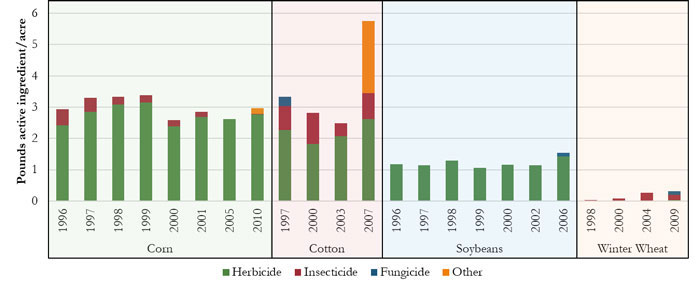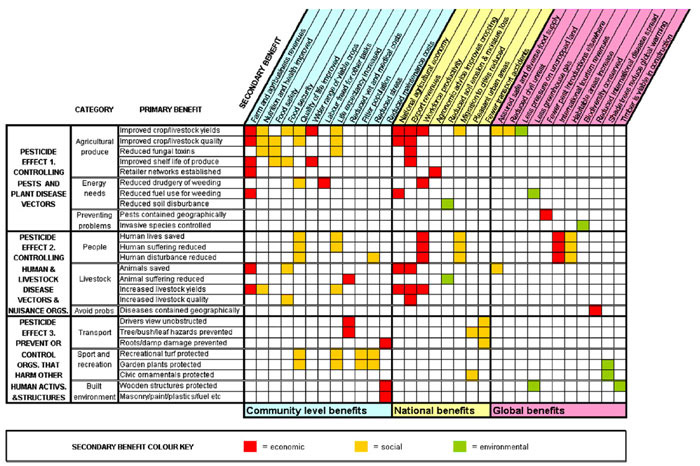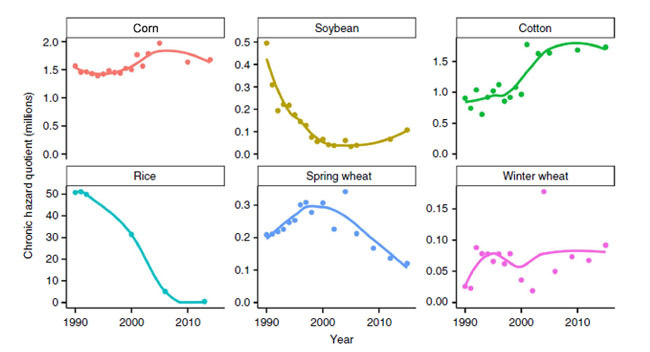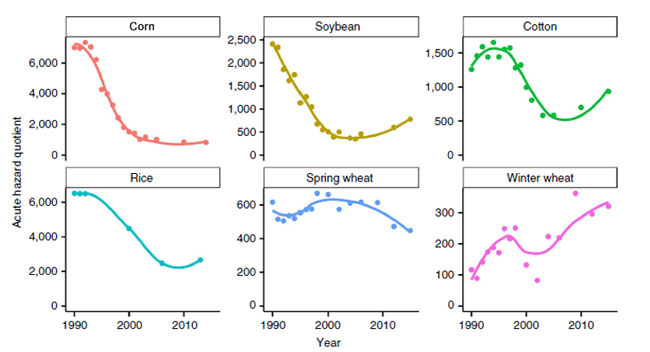Excerpted from the Environmental Impact of Missouri Crop Production report
- Farmers are using more pounds of pesticide.
- Almost 100% of crop acres have some type of pesticide applied to them.
The proper use of pesticides has helped crop production become more efficient and sustainable. Herbicide use allows for less tillage. Insecticide use allows crops to yield more per plant and acre. Fungicide use allows grain to be in better condition and maintain its nutritional and processing quality for longer periods of time.
The quantity of pesticides used is increasing and is likely to continue to increase. Factors contributing to increased pesticide use include the introduction of invasive species of pests, the development of pesticide resistance in pests formerly controlled and the development of new pesticides for previously uncontrolled pest problems.
The USDA NASS Agricultural Chemical Use Survey tracks pesticide adoption by crop for key production regions (not exclusive of Missouri). The table below summarizes the share of planted U.S. corn, cotton, rice, soybean and winter wheat acreage which had various treatments in years with the most recent data available.
| Crop (data year) | Insecticide | Herbicide | Fungicide | Other |
|---|---|---|---|---|
| Corn (2016) | 16% | 97% | 12% | 1% |
| Cotton (2015) | 40% | 92% | 1% | 76% |
| Rice (2013) | 28% | 97% | 49% | 4% |
| Soybeans (2015) | 22% | 96% | 11% | 1% |
| Winter wheat (2015) | 5% | 61% | 19% | NA |
| NA: Estimate doesn't comply with NASS disclosure practices, is not available or is not applicable. Source: USDA NASS Agricultural Chemical Use Survey (multiple years) |
||||
The USDA data reveals that Missouri is similar to the U.S. Trends over time indicate that Missouri corn and soybean acres that have been treated with herbicides have remained over 90% almost every year since 1990. The image below shows the quantity of pesticides applied for principal crops grown in Missouri.
Chemical applications per acre by crop in Missouri, 1996–2010

Source: USDA ARMS Survey
Secondary benefits are longer term and more difficult to establish causality. The primary benefit refers to benefits that are immediate and incontrovertible. The image below summarizes the economic, social and environmental benefits of various types of pesticides.
Benefits of pesticides

Source: Jerry Cooper and Hans Dobson, Crop Protection 26 (2007) 1337–1348
Herbicides
- Farmers are using more pounds of herbicide.
- The acute hazard quotient associated with herbicides increased for winter wheat but decreased for corn, soybean, cotton and rice from 1990 to 2015.
- The chronic hazard quotient associated with herbicides remained relatively flat for corn and winter wheat but increased for cotton and decreased for soybean and rice from 1990 to 2015.
- Herbicide resistance in weeds is creating challenges for Missouri farmers.
- Without herbicides, crop production would become less efficient, and acreage would have greater erosion problems.
Herbicide use in row-crop production has increased during the past 10 years in Missouri and the rest of the U.S. Corn, soybean and cotton are predominately glyphosate-resistant crops. The Union of Concerned Scientists has blamed the increased use of herbicides on glyphosate-resistant crop production. However, data indicate herbicide applications to rice and wheat, which have no GMO varieties, have also increased.
The environmental impact of the increased herbicide use is best measured using a hazard quotient approach. The toxicity of each herbicide represents the hazard, and the amount of the herbicide applied represents an estimate of exposure. Chronic toxicity is measured as the 24-month oral dose that has no observable effect on rats. Acute toxicity is measured by the oral dose that kills 50% of rats (LD50).
Herbicide chronic hazard quotient, 1990–2015

Source: Kniss, Nature Communications
Herbicide acute hazard quotient, 1990–2015

Source: Kniss, Nature Communications
Herbicides benefit farmers by providing better, more reliable weed control at a lower cost than tillage. Better weed control results in higher yields and increased incomes. Herbicide use has also reduced farm-related injuries from hoeing and use of farm equipment.
Apart from the toxicity measure, herbicides also benefit the environment. Replacing cultivation with herbicides has resulted in lower carbon emissions from both less fuel use and greater carbon sequestration, less soil erosion, less soil compaction and less water use.
Insecticides
- Farmers are using fewer pounds of insecticide.
- Farmers have adopted better management practices called integrated pest management.
- Chemical companies have developed safer insecticides, which have a less significant environmental footprint.
The USDA reports insecticide use peaked in 1972 with 158 million pounds being used. In contrast, 29 million pounds were used in 2008.
Concerns with the use of insecticides abound. Contamination of water and soil resources can negatively affect birds, fish and mammals. Agricultural worker and food safety concerns also arise.
The level of testing required to introduce a new insecticide along with the safeguards enforced by state and federal regulatory agencies have mitigated many of these concerns. During the past 30 years, new pesticides have been introduced to be safer to use, have a lower environmental footprint, be more pest-specific and be more precisely applied at extremely low rates.
Crop producers now use integrated pest management (IPM) extensively in row-crop production. Insecticides that had high environmental concerns (e.g. organochlorines) and high toxicity have been, and are continuing to be, replaced by lower risk, biological and user-friendly materials. Insect growth regulators take advantage of pest biology to provide improved management of pests. This improved management reduces losses due to pests and minimizes the effect on nontarget organisms and the environment. Introducing genetically modified crops that confer pest resistance (e.g. Bt corn and cotton) also reduces dependence on chemical controls.